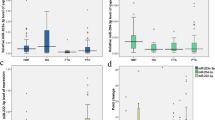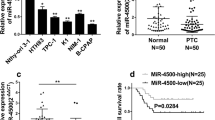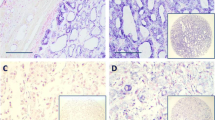Abstract
Purpose
To investigate the overexpression of miR-221 in papillary thyroid carcinoma (PTC), we developed a Gaussia luciferase (Gluc) system regulated by miR-221.
Procedures
Quantities of primary or mature miR-221 in normal thyroid cells (HT-ori3) and in PTC (NPA, TPC-1) were measured by quantitative real-time polymerase chain reaction. Cytomegalovirus (CMV)/Gluc-3xPT_miR221, which included three perfect complementary target sequences repeats of miR221 in the 3′-untranslated region of Gluc, was transfected into cells with pre-miR-221 or anti-miR-221 and Gluc activities were then compared in vitro and in vivo.
Results
Primary or mature miR-221 were overexpressed in PTC as compared with HT-ori3. In cells transfected with the Gaussia luciferase reporter system (CMV/Gluc-3xPT_miR221), Gluc activities were regulated according to miR-221 levels in vitro and in vivo.
Conclusions
These results suggest that the devised CMV/Gluc-3xPT_miR221 system may be a useful tool for monitoring quantities of endogenous miR-221 in cells or living organisms.




Similar content being viewed by others
References
Lee RC, Feinbaum RL, Ambros V (1993) The C. elegans heterochronic gene lin-4 encodes small RNAs with antisense complementarity to lin-14. Cell 75:843–854
Lu J, Getz G, Miska EA et al (2005) MicroRNA expression profiles classify human cancers. Nature 435:834–838
Kloosterman WP, Plasterk RH (2006) The diverse functions of microRNAs in animal development and disease. Dev Cell 11:441–450
Reinhart BJ, Slack FJ, Basson M et al (2000) The 21-nucleotide let-7 RNA regulates developmental timing in Caenorhabditis elegans. Nature 403:901–906
Bushati N, Cohen SM (2007) microRNA functions. Annu Rev Cell Dev Biol 23:175–205
Kim VN (2005) MicroRNA biogenesis: coordinated cropping and dicing. Nat Rev Mol Cell Biol 6:376–385
Zeng Y, Yi R, Cullen BR (2003) MicroRNAs and small interfering RNAs can inhibit mRNA expression by similar mechanisms. Proc Natl Acad Sci U S A 100:9779–9784
Valencia-Sanchez MA, Liu J, Hannon GJ, Parker R (2006) Control of translation and mRNA degradation by miRNAs and siRNAs. Genes Dev 20:515–524
Obernosterer G, Leuschner PJ, Alenius M, Martinez J (2006) Post-transcriptional regulation of microRNA expression. Rna 12:1161–1167
Weiler J, Hunziker J, Hall J (2006) Anti-miRNA oligonucleotides (AMOs): ammunition to target miRNAs implicated in human disease. Gene Ther 13:496–502
Brennecke J, Hipfner DR, Stark A, Russell RB, Cohen SM (2003) bantam encodes a developmentally regulated microRNA that controls cell proliferation and regulates the proapoptotic gene hid in Drosophila. Cell 113:25–36
Osada H, Takahashi T (2007) MicroRNAs in biological processes and carcinogenesis. Carcinogenesis 28:2–12
Tsuchiya S, Okuno Y, Tsujimoto G (2006) MicroRNA: biogenetic and functional mechanisms and involvements in cell differentiation and cancer. J Pharmacol Sci 101:267–270
Zhang B, Pan X, Cobb GP, Anderson TA (2007) microRNAs as oncogenes and tumor suppressors. Dev Biol 302:1–12
Esquela-Kerscher A, Slack FJ (2006) Oncomirs—microRNAs with a role in cancer. Nat Rev Cancer 6:259–269
Pallante P, Visone R, Ferracin M et al (2006) MicroRNA deregulation in human thyroid papillary carcinomas. Endocr Relat Cancer 13:497–508
Felli N, Fontana L, Pelosi E et al (2005) MicroRNAs 221 and 222 inhibit normal erythropoiesis and erythroleukemic cell growth via kit receptor down-modulation. Proc Natl Acad Sci USA 102:18081–18086
He H, Jazdzewski K, Li W et al (2005) The role of microRNA genes in papillary thyroid carcinoma. Proc Natl Acad Sci U S A 102:19075–19080
Nikiforova MN, Tseng GC, Steward D, Diorio D, Nikiforov YE (2008) MicroRNA expression profiling of thyroid tumors: biological significance and diagnostic utility. J Clin Endocrinol Metab 93(5):1600–1608
Gillies JK, Lorimer IA (2007) Regulation of p27Kip1 by miRNA 221/222 in glioblastoma. Cell Cycle 6:2005–2009
Doubrovin M, Serganova I, Mayer-Kuckuk P, Ponomarev V, Blasberg RG (2004) Multimodality in vivo molecular-genetic imaging. Bioconjug Chem 15:1376–1388
Lee JY, Kim S, Hwang DW et al (2008) Development of a dual-luciferase reporter system for in vivo visualization of MicroRNA biogenesis and posttranscriptional regulation. J Nucl Med 49(2):285–294
Ottobrini L, Ciana P, Biserni A, Lucignani G, Maggi A (2006) Molecular imaging: a new way to study molecular processes in vivo. Mol Cell Endocrinol 246:69–75
Gould SJ, Subramani S (1988) Firefly luciferase as a tool in molecular and cell biology. Anal Biochem 175:5–13
Brasier AR, Tate JE, Habener JF (1989) Optimized use of the firefly luciferase assay as a reporter gene in mammalian cell lines. Biotechniques 7:1116–1122
Tannous BA, Kim DE, Fernandez JL, Weissleder R, Breakefield XO (2005) Codon-optimized Gaussia luciferase cDNA for mammalian gene expression in culture and in vivo. Mol Ther 11:435–443
Acknowledgements
This work was funded by the Korean Science and Engineering Foundation (KOSEF) grant funded by the Korea government (MOST; No. 2007-02242), National R&D Program for Cancer Control of Ministry of Health & Welfare (0820320), and Seoul R&BD program. H.J. Kim was supported by the BK21 Project for Medicine, Dentistry, and Pharmacy in Korea (2007).
Author information
Authors and Affiliations
Corresponding authors
Rights and permissions
About this article
Cite this article
Kim, H.J., Chung, JK., Hwang, D.W. et al. In Vivo Imaging of miR-221 Biogenesis in Papillary Thyroid Carcinoma. Mol Imaging Biol 11, 71–78 (2009). https://doi.org/10.1007/s11307-008-0188-6
Received:
Revised:
Accepted:
Published:
Issue Date:
DOI: https://doi.org/10.1007/s11307-008-0188-6




